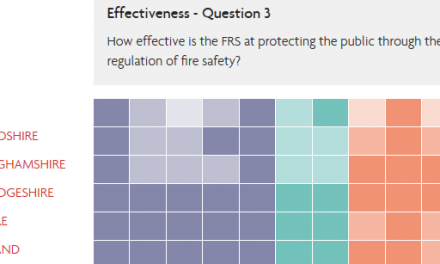Article 5 and the Domestic Tenant
The interrelationship between the Fire Safety Order and the Housing Act is complicated and the best of times, so it is not surprising that the role of the domestic tenant within fire safety enforcement is often unclear.
I have lost count of the number of times that I have been told that the FSO does not apply to domestic premises and applies only to the common areas. Of course, this is broadly correct, but what is often forgotten is that the Order applies to any structure that acts to protect the common areas from fire and smoke, and in particular, any structure which protects the means of escape.
Article 5 states that persons other than the responsible person (as defined by Article 3) acquire duties under the Order if they have, to any extent, control of those premises so far as the requirements relate to matters within (their) control. It follows, therefore, that if a flat entrance door leads onto the means of escape and that door is within the control of the tenant, it is the tenant’s responsibility to ensure that the door is suitable to comply with the requirements of the Order.
A tenant may have a duty to ensure the safety of the premises as a result of a clause in their contract or tenancy. Most tenancy agreements will contain such a clause. Some agreements go further and state that the condition of the property and its contents are deemed to be in good repair thus placing a duty upon the tenant to notify the landlord of any failings in the fire safety management of the premises.
So even at a very basic level, a tenant is likely to have some responsibilities under the Order due to their limited control for fire safety within premises. Enforcement may be considered against the tenant where they have failed to act in accordance with their tenancy agreement or, for example, when asked to replace an existing door with a fire door by an enforcing authority.
But tenants may also be liable for their actions as well as for their omissions. Consider the tenant who removes the self-closing device on a door leading to the fire escape. In the event of fire this could place relevant persons at risk of death or serious injury. I have dealt with numerous cases where detector heads have been covered and fire alarms regularly silenced by tenants (usually upset by the number of false alarms!). Recently, I prosecuted a tenant who was residing permanently in a hotel prohibited for use on the upper floors, but who decided to sublet the empty rooms to local workmen. As the prohibition notice had been served upon the tenant as well as the landlord, I argued that he had sufficient control of the premises to acquire responsibilities under article 5 (3) of the Order. He received a suspended custodial sentence.
In that case there was clearly a risk of death or serious injury. But enforcement action may also be considered where there is no such risk, for example, when an enforcement notice is being considered. Where aspects of the compliance required are the responsibility of the tenant, it would be appropriate to serve a suitably worded enforcement notice upon the tenant, (obviously limited to matters within the tenant’s control).
And is the tenant required to work with other responsible persons such as the landlord or managing agent to ensure that fire safety compliance is met? In my opinion he is. I refer to the CFOA Collected Perceived Insights document which confirms that it is the intention of Article 22 to require responsible persons and duty holders who share premises to take all reasonable steps to coordinate the measures they take to provide general fire precautions in respect of relevant persons. I consider tenants in domestic premises to be potential duty holders in such situations.



